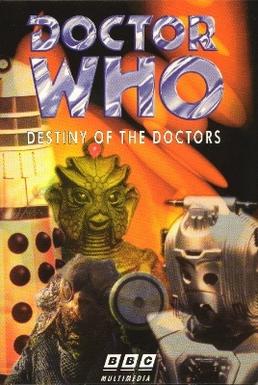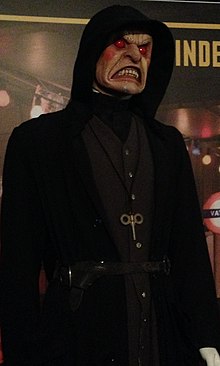
Davros is a character from the long-running British science fiction television series Doctor Who. He was created by screenwriter Terry Nation, originally for the 1975 serial Genesis of the Daleks. Davros is a major enemy of the series' protagonist, the Doctor, and is the creator of the Doctor's deadliest enemies, the Daleks. Davros is a genius who has mastered many areas of science, but also a megalomaniac who believes that through his creations he can become the supreme being and ruler of the Universe. The character has been compared to the infamous dictator Adolf Hitler several times, including by the actor Terry Molloy, while Julian Bleach defined him as a cross between Hitler and the renowned scientist Stephen Hawking.

The Cybermen are a fictional race of cyborgs principally portrayed in the British science fiction television programme Doctor Who. The Cybermen are a species of space-faring cyborgs who often forcefully and painfully convert human beings into more Cybermen in order to populate their ranks while also removing their emotions and personalities. They were conceived by writer Kit Pedler and story editor Gerry Davis, and first appeared in the 1966 Doctor Who serial The Tenth Planet.

The Silurians are a race of reptilian humanoids in the long-running British science fiction television series Doctor Who. The species first appeared in Doctor Who in the 1970 serial Doctor Who and the Silurians, and were created by Malcolm Hulke. The first Silurians introduced are depicted as prehistoric and scientifically advanced sentient humanoids who predate the dawn of man; in their backstory, the Silurians went into self-induced hibernation to survive what they predicted to be a large atmospheric upheaval caused by the Earth capturing the Moon.
The Robots of Death is the fifth serial of the 14th season of the British science fiction television series Doctor Who, which was first broadcast in four weekly parts on BBC1 from 29 January to 19 February 1977.

James Robert McCrimmon, usually simply called Jamie, is a fictional character played by Frazer Hines in the long-running British science fiction television series Doctor Who. A piper of the Clan MacLeod who lived in 18th-century Scotland, he was a companion of the Second Doctor and a regular in the programme from 1966 to 1969. The spelling of his surname varies from one script to another; it is alternately rendered as Macrimmon and McCrimmond. Jamie appeared in 20 stories.

Steven Taylor is a fictional character played by Peter Purves in the long-running British science fiction television series Doctor Who. A space pilot from Earth in the future, he was a companion of the First Doctor and a regular in the programme from 1965 to 1966. Steven appeared in 10 stories. Only three of the serials in which Steven appeared as a regular are complete in the BBC archive.

Kaldor City is a series of audio plays using elements from the British TV series Doctor Who and Blake's 7. Many of the elements borrowed from these series for use in Kaldor City were originated by Chris Boucher, who wrote for Doctor Who and was script editor for all four seasons of Blake's 7. The series, produced by Magic Bullet Productions, was released on CD beginning in 2001.

The Ice Warriors are a fictional extraterrestrial race of reptilian humanoids in the long-running British science fiction television series Doctor Who. They were originally created by Brian Hayles, first appearing in the 1967 serial The Ice Warriors where they encountered the Second Doctor and his companions Jamie and Victoria. In Doctor Who, the Ice Warriors originated on Mars, which within the series narrative is a dying world. Their early appearances depict the Ice Warriors as attempting to conquer the Earth and escape their planet as early as Earth's Ice Age. A frozen group are discovered by an Earth scientific team who dub them 'Ice Warriors' in their first appearance. Despite this not being the name of their species, an Ice Lord later refers to his soldiers as Ice Warriors in the 1974 serial The Monster of Peladon. Similarly there is a fleeting reference to themselves as such in The Curse of Peladon. Although originally appearing as villains, subsequent appearances have depicted Ice Warriors that have eschewed violence and even ally themselves with the Doctor. They have also been featured in flashback and cameo appearances, in addition to appearing frequently in spin-off media such as novels and audio releases.
Revenge of the Cybermen is the fifth and final serial of the 12th season of the British science fiction television series Doctor Who, which was first broadcast in four weekly parts on BBC1 from 19 April to 10 May 1975. It was the first to feature the Cybermen since The Invasion (1968) and the last until Earthshock (1982).

The Chase is the eighth serial of the second season in the British science fiction television series Doctor Who. Written by Terry Nation and directed by Richard Martin, the serial was broadcast on BBC in six weekly parts from 22 May to 26 June 1965. Set in multiple time periods on several different planets, including Aridius, Earth, and Mechanus, the serial features the Dalek race travelling through time while pursuing the time machine the TARDIS and its occupants—the First Doctor and his companions Ian Chesterton, Barbara Wright, and Vicki —to kill them and seize the TARDIS for themselves. The Doctor and companions encounter several characters, including monsters Dracula and Frankenstein's monster, human astronaut Steven Taylor, and an android replica of the Doctor.

The First Doctor is an incarnation of the Doctor, the protagonist of the BBC science fiction television series Doctor Who. He was portrayed by actor William Hartnell.
The Daleks are a fictional extraterrestrial race of mutants from the British science fiction television series Doctor Who. The mutated remains of the Kaled people of the planet Skaro, they travel around in tank-like mechanical casings, and are a race bent on universal conquest and destruction. They are also, collectively, the greatest alien adversaries of the Time Lord known as the Doctor, having evolved over the course of the series from a weak race to monsters capable of destroying even the Time Lords and achieving control of the universe.
The Invasion is the partly missing third serial of the sixth season of the British science fiction television series Doctor Who, which was first broadcast in eight weekly parts from 2 November to 21 December 1968.

Doctor Who: Destiny of the Doctors is an action video game based on the BBC British science fiction television series Doctor Who. It was released on 5 December 1997 by BBC Multimedia.
"Rise of the Cybermen" is the fifth episode of the second series of the British science fiction television programme Doctor Who, which was first broadcast on BBC One on 13 May 2006. The episode introduces a terrestrial reinvention of the Cybermen, as well as a parallel universe which would serve as a recurring plot element in the series. It is the first part of a two-part story, the concluding part being "The Age of Steel", broadcast on 20 May.
Alan Stevens is a British writer and producer who is based in the Southeast of England, where he runs his own audio production company, Magic Bullet Productions.

The twelfth season of British science fiction television series Doctor Who began on 28 December 1974 with Tom Baker's first serial Robot, and ended with Revenge of the Cybermen on 10 May 1975.






















